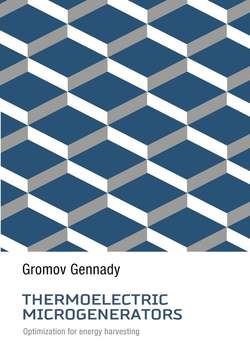Читать книгу Thermoelectric Microgenerators. Optimization for energy harvesting - Gennady Gromov - Страница 3
На сайте Литреса книга снята с продажи.
Chapter 1. Introduction
ОглавлениеCreation of alternative, first of all renewable, power sources is the perspective direction of development of power engineering in the world now. The whole direction under definition “green power” (green energy) was appead.
It is the power engineering based on renewable natural sources of heat, causing the minimum damage to the environment, safe and eco-friendly. The big section of new power engineering is the direction of utilization of waste heat of the sources surrounding the person. Including, very interestingly, – thermal emission of a human body.
It should be noted that due to the nature of these heat sources, this is small power engineering. It received a general definition- energy harvesting.
To transform the energy of such energy sources it is possible to use devices that are based on different physical principles: electrodynamic, photovoltaic (small solar panels), piezoelectric and thermoelectric (microgenerators).
Every of the above types of energy converters has its advantages and disadvantages at the same time. And mostly they still compete for the tasks of energy harvesting at the level of concepts and laboratory projects.
Thermoelectric (TE) converters, thermoelectric generators (TEG) have several advantages over other mentioned:
– “omnivore” – convert any weak heat flow, all sources, including the heat of the human body.
– all-weather is not dependent on the daylight cycle (as solar panels).
– latent installations, due to the very small size, which is important for masking.
– highest reliability and long service life (over 25 years).
– no moving parts, no noise, do not need periodic maintenance.
In accordance with recent forecasts [1], [2], the direction of thermoelectric converters of thermal energy in the coming years will be developed into a large segment of the world market with a volume of about 1 billion dollars to 2024 (see Chapter 17).
Thermoelectric generators have, as we know, very low conversion efficiency, which is no more than 15—20% of the Carnot cycle efficiency. It is only few percent of conversion of energy from a heat source.
In energy harvesting applications, where natural heat sources have a slight temperature, generator is working at very low temperature differences and therefore, a fortiori, with very low levels of efficiency.
Although it is most commonly “waste” energy and low efficiency seems to be tolerated, but efficiency remains a key challenge of thermoelectric generators
In this regard, optimization of all aspects of device design and materials of thermoelectric generator is a very pressing task of extracting maximum effectiveness in their application.
The primary task is to develop an efficient thermoelectric material. This is a key component of the device as a whole, determining its main parameters. It is important to obtain material with not only high thermoelectric efficiency, but also sufficiently high mechanical properties. It is the task of the semiconductor materials science where there are their approaches, achievements and expectations.
The second task is the optimum design parameters to ensure the effectiveness of the device in general. It includes development of methods of constructing of optimal thermoelectric microgenerators with available thermoelectric materials.
This book discusses a range of aspects of optimization of thermoelectric microgenerators, their applications in directions of energy harvesting. Interrelations of various parameters are demonstrated, various nuances of operation of thermoelectric microgenerators are discussed.
We will discuss thermoelectric generators in whole, but meaning their miniature (micro – is a slang) types suitable for energy harvesting, small-scale power engineering.
